By Carl Zulauf
The Chairman of the House Agriculture Committee recently released additional details of a farm bill proposal in advance of a markup scheduled for May 23, 2024. (House Agriculture Committee, Press Release, May 10, 2024). At the top is a 10% to 20% increase to statutory reference prices to “account for persistent inflation and rising costs of production” (House Agriculture Committee, Title-by-Title Summary, May 10, 2024). Important details are yet to be released (which crops receive what level of increase; how much it will cost), but the emphasis is clear and recent history provides guidance on what to expect. The recent proposal by the Chairwoman of the Senate Agriculture, Nutrition, and Forestry Committee is also instructive, proposing increases to statutory reference prices only for seed cotton, rice, and peanuts (Senate ANF Committee, Section-by-Section, May 1, 2024). Without a change in trajectory, any 2024 Farm Bill is likely to produce different reference price increases for different program crops. Doing so will add to the existing disparities among farmers. Increasing reference prices has important implications on the topline spending projections by CBO (see e.g., farmdoc daily, May 14, 2024). Buried beneath these projections are implications for farmers. Critical to this is an oddity unique to the farm payment programs (Agriculture Risk Coverage (ARC) and Price Loss Coverage (PLC)): base acres. The payments from these programs are decoupled from what a farmer plants and, thus, from the risks of producing the crop, as well as its costs. This article discusses some of the implications of the imbalance in reference prices and base acres.
Background
Since 1996, all primary farm payment programs—from direct payments and counter-cyclical payments to the Agriculture Risk Coverage (ARC) and Price Loss Coverage (PLC) programs—have been decoupled from the planting decisions of farmers and thus from actual production costs and revenue risks that farmers face (see e.g., farmdoc daily, May 7, 2024; July 20, 2023; August 3, 2023; August 10, 2023; August 17, 2023; August 31, 2023; August 26, 2022; September 26, 2022). Today’s base acres trace to the contract acres fixed in the 1996 Farm Bill that used the base acreage system enacted in the 1985 and 1990 Farm Bills (P.L. 104-127); P.L. 101-916; P.L. 99-198). Congress authorized a voluntary base acreage update in the 2002 Farm Bill, followed by a voluntary base acre reallocation in the 2014 Farm Bill (P.L. 107-171; P.L. 113-79). The odd and esoteric nature of this policy design is easily lost or obscured but the bottom line is relatively straightforward: payments a farmer receives from ARC or PLC are made on the acres historically planted to a crop, possibly as far back as the 1980s, not on the actual acres planted in the crop year associated with the payment. In other words, a farmer with corn base acres can receive payments for corn under ARC and PLC (if triggered) while planting a different crop—such as soybeans—on those base acres. This design was meant to avoid having the federal payments, or potential for payments, influence the farmer’s decision as to which crop(s) to plant; large payments to some program crops could result in more acres planted to those crops, leading to lower prices and still larger payments as well as commodity title costs.
As the discussion below clarifies, problems with this policy design result from Congressional decisions in establishing the payment thresholds (e.g., reference prices) at different rates or levels. When Congress elects to establish a payment threshold for some program crops at higher levels than others, the consequences on the ground are that farmers with base acres in those favored crops receive larger payments while being able to plant other crops on their farms.
As review, PLC payments are triggered when a crop’s Marketing Year Average (MYA) price is below the Effective Reference Price (ERP) for the program crop, with the ERP being the higher of the Statutory Reference Price (SRP) or 85% of the five-year Olympic moving average of MYA prices (not to exceed 115% of the SRP). When MYA is below ERP, the difference (or deficiency) results in a payment rate, which is multiplied by a fixed program yield and paid on 85% of the program crop’s base acres. The disparities in reference prices, as they play out through base acres versus planted acres, result in significant differences in support levels for farmers in different regions. For example, the most recent Congressional Budget Office (CBO) projections would average PLC payments of $120 per base acre for peanuts, $58 for all rice, $30 for seed cotton, $29 for corn, $10 for wheat, and $6 for soybeans (CBO, February 2024; farmdoc daily, May 14, 2024). A farmer with base acres of a high payment crop like rice or peanuts can receive the larger payments without incurring the costs or risks associated with those crops, while planting a crop like soybeans with lower relative costs and risks.
Discussion
The recent Title-by-Title Summary of the proposal in the House indicated that all crops would receive an increase in statutory reference prices between 10% and 20% (7 U.S.C. §9011). The likely result from this will be different rates of increase by crop and, if history is any indication, the largest increases are likely going to rice, peanuts, seed cotton and other smaller acreage crops, while smaller increases will be applied to the larger acreage program crops of corn, wheat, and soybeans. It is possible that soybeans could be an exception because current reference prices are significantly below market prices and a larger percentage increase would not have the same cost implications.
The discussion that follows uses the following assumptions for the level of reference price increases for the major program crops: highest level (20%) for long grain rice and peanuts; mid-level (15%) for wheat, soybeans, and seed cotton; lowest level (10%) for corn and grain sorghum.
Figure 1a illustrates the differences among current reference prices based on the actual payment rates under PLC since 2014 as reported by the Farm Service Agency (USDA-FSA, ARC/PLC Program Data). Figure 1b illustrates the differences if the House proposal were enacted for crop years 2025 to 2029 (presumably those covered by a 2024 Farm Bill), using the Congressional Budget Office (CBO) projections for MYA prices in the February 2024 baseline update (CBO, February 2024). The comparison here is the PLC payment rate as a percentage of the actual or projected MYA for each program crop. Note that CBO reports only an all-rice MYA and the MYA used throughout is based on the historic relationship between the all-rice and long grain rice MYA.
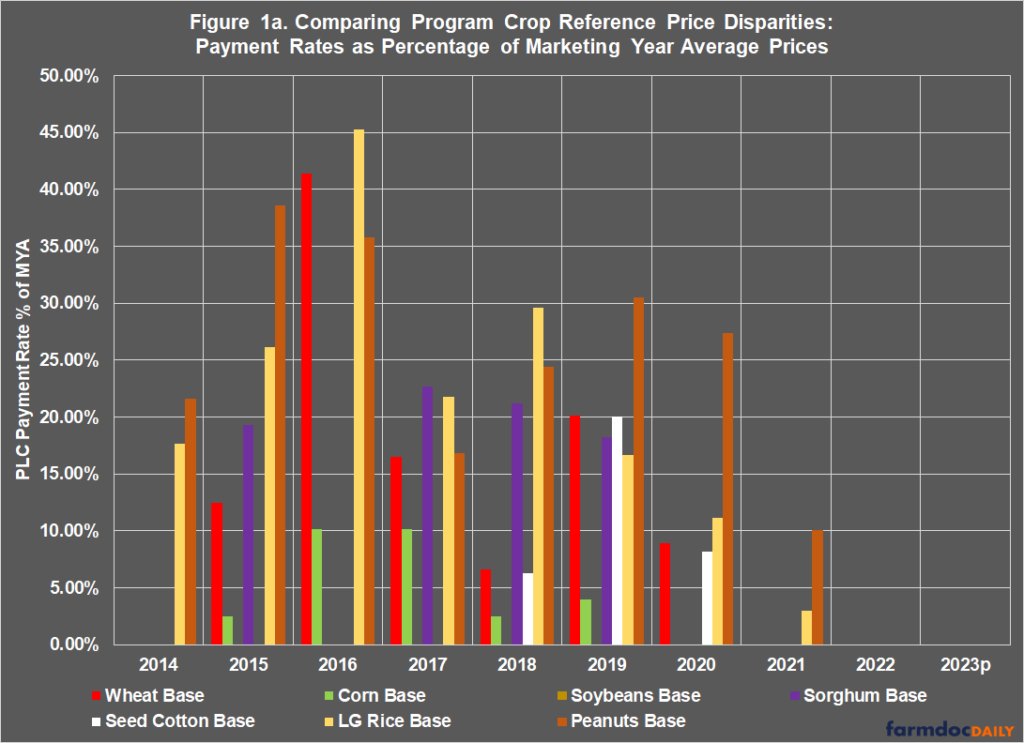
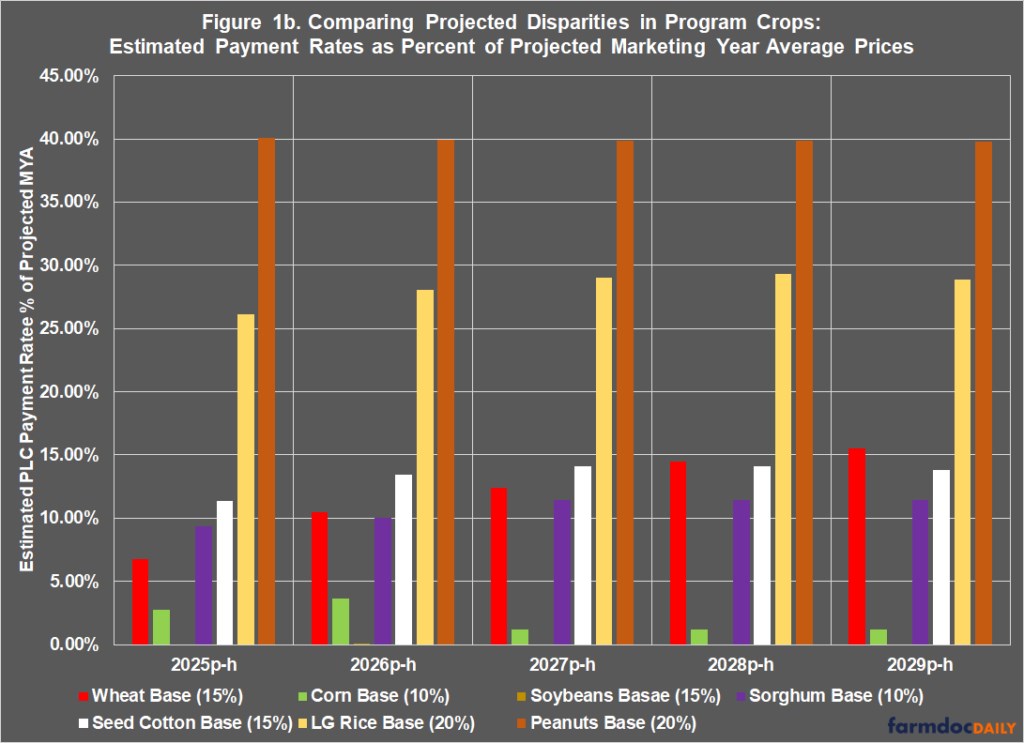
Figure 2 illustrates what happens when farmers plant soybeans on base acres for each of the major program crops under SRP increases at the different levels noted above. Figure 2 uses the price, yield, and PLC program yields reported by CBO in the February 2024 update to compare total revenue across program crop base acres for the presumed 2024 Farm Bill (crop years 2025 to 2029). The total revenue equals the projected PLC payment for each program crop base acre (factored by 85%) added to the national average revenue for soybeans per acre planted. Farmers in this scenario are planting the same crop (soybeans); farmers who plant soybeans on base acres for peanuts, long grain rice, and seed cotton would receive significantly more total revenue per acre (soybean revenue plus PLC payment per base acre) compared to farmers planting soybeans on the base acres of the other major program crops, especially soybeans.
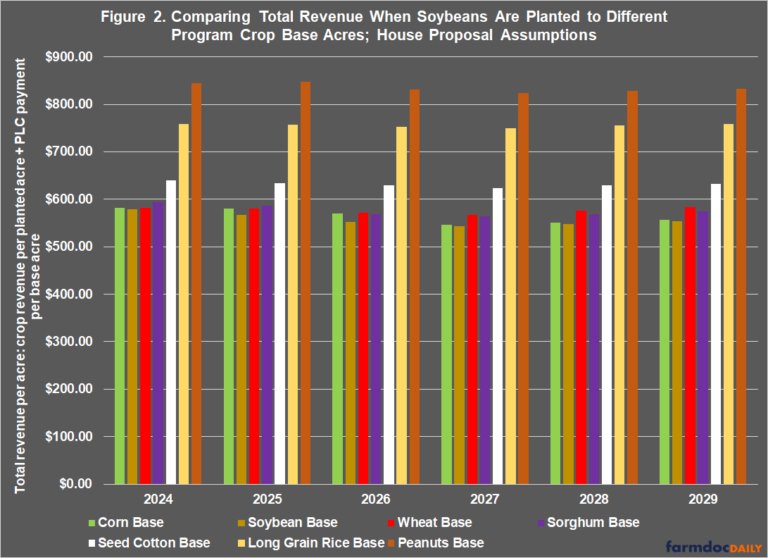
Figure 3 illustrates the same scenario for farmers planting corn on different program crop base acres and thus receiving the corn revenue per actual planted acre and the PLC payment for the alternative program crop base acre.
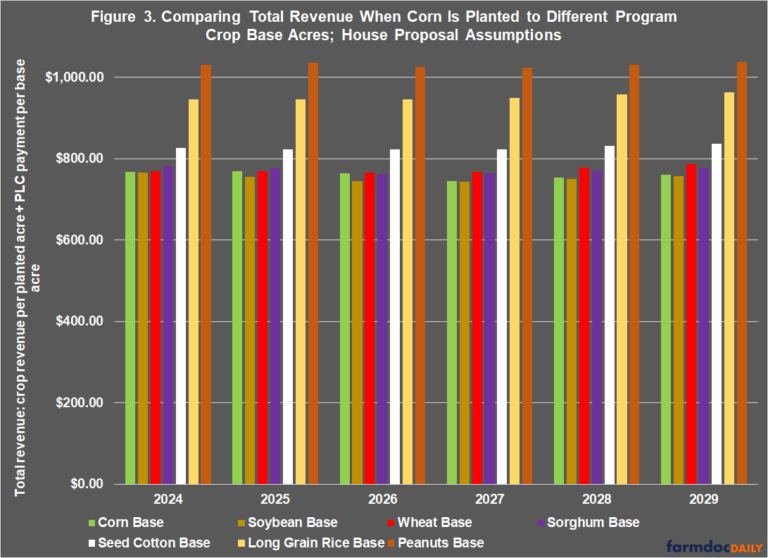
Both Figures 2 and 3 present scenarios much closer to the farmer’s perspective as compared to the baseline or CBO cost projection perspective discussed previously (farmdoc daily, May 14, 2024). The differences in reference prices on base acres translate into different total revenue for farmers who plant the same crops but have different base acres on the farm because the payments on base acres are disconnected from the costs of the crop planted and the risks in producing it. This has been the experience for farmers under PLC since it was first enacted in 2014 as provided in Table 1.
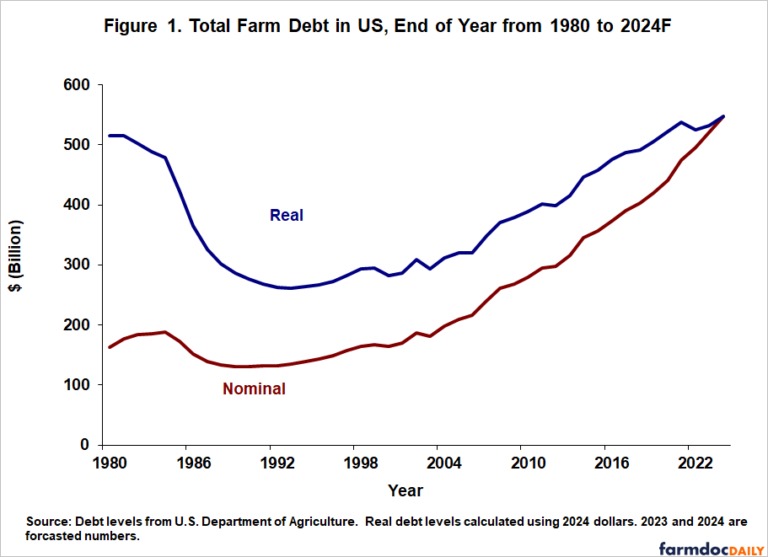
A comparison that results in 100% would be those years in which the program crop did not receive a PLC payment and the farmer’s total revenue would be the planted crop revenue (soybeans or corn). A comparison that results in less than 100% would be a year in which corn base received a PLC payment but the alternative program crop did not (e.g., planting corn on soybean base). In most years, farmers with peanuts, long grain rice, and seed cotton who planted soybeans or corn received significantly more total revenue than farmers with other program crop base. If Congress elects to increase reference prices by different levels for the program crops and leaves base acres unchanged, it is highly likely to increase these disparities.
Concluding Thoughts
ARC and PLC are unique among all farm policies in that the programs are designed to have payments that are decoupled from current planting decisions made by farmers. For crop insurance, the farmer pays a portion of the premium for an insurance policy on the actual crop planted and for which the costs are incurred, as well as the risks. With conservation assistance, the farmer or landowner receives a payment in return for adopting conservation practices on the farm. When disparities in payment thresholds are enacted by Congress, the impacts are different for farmers depending on which base acres the farmer has on the farm. Farmers can plant the same crops, face the same prices, incur the same production costs, and manage the same risks but receive very different payments and thus different total revenue. This issue is largely ignored in the Farm Bill deliberations because of the priority given to CBO cost projections whereby relatively small payments for crops with large amounts of base acres (corn, soybeans, and wheat) have much higher scores than relatively large payments for crops with small amounts of base acres (seed cotton, rice, and peanuts). These cost projections are irrelevant to farmers, however, because the per-base-acre payment amounts are what they receive as part of their farm’s revenue.
Source : illinois.edu